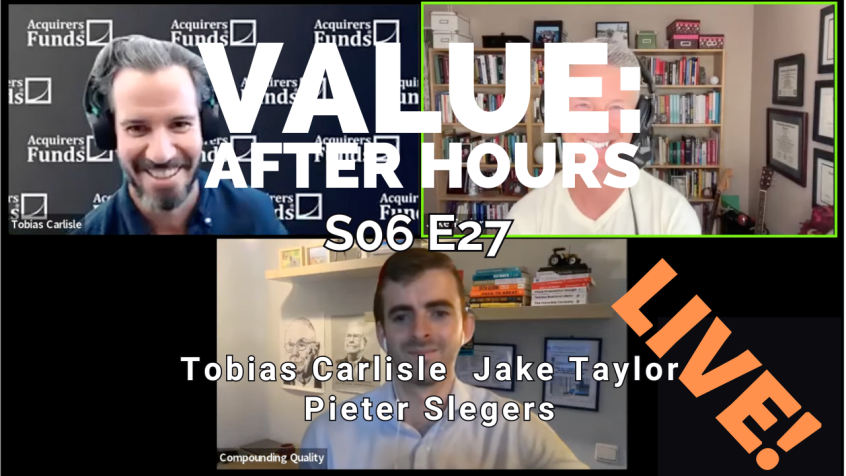During their recent episode, Taylor, Carlisle, and Pieter Slegers discussed Adapting Your Investment Strategy: Evolving with Market Changes, here’s an excerpt from the episode:
Pieter: Yeah, sure. So, I think, for example, once again compare value with quality investing, well, for value investors, the margin of safety is at a low valuation. So, what you do is you try to buy a company. You think is cheaply valued; you buy it. If your investment is correct, well, the under valuation goes away, and stock goes up and you sell the company because it’s fairly valued and you do it again and again and you need to find a new undervalued company.
With quality investing, well, your margin of safety is in the moat. When your assumption is correct, when your homework is correct, and indeed the company has a sustainable competitive advantage and they had a competitive advantage 20 years ago, they have one today. When it still has one in 20 years from now, that usually means that they are very strong in their business and that they indeed are able to grow at above average rates for very long periods of time, then you come back to the DCF example for UF, we talked about Visa, Mastercard, same for S&P Global and so on.
S&P Global was the market leader 20 years ago. They are the market leader today. They got a lot of bad stuff going on during the financial crisis, but even that didn’t manage to take away their dominant position, basically. So, also, likely that in 10 years from now, in 15 years from now, it’s still the case.
For whatever company that’s in the stock market today, when you with run a DCF, that’s where the company can go at the above average rates for 15 or 20 years, almost every company looks undervalued. Obviously, that’s a very dangerous thing to do, because when a company loses its moat, the valuation comes down and the growth comes down. So, it’s a double-edged sword in a negative sense. But I think that’s what’s really happening.
There is an example, when you would have bought the S&P in the 30s at five times earnings, so that’s the best possible moment you could have ever bought the S&P, and you would have sold it just before the dotcom crisis at 30 times earnings. So, you have multiple expansions that went six times as high. Your return would be around 12% per year from 1930 until 2000 or 1999. Only 1.5% to 2% of that is for multiple expansion. All the rest is from the growth of the intrinsic value.
So, when you have an investment horizon of 10 years of more, the intrinsic value is truly what matters. When you have a period of one year, it’s the multiple expansion or the changes in the valuation, that’s what matters the most for pure old school value investors, in the Benjamin Graham sense of the word. Then in the medium term, it’s more than the earnings growth and so on. And then on the very long-term, it’s more the culture of the company, the value that is created. So, I think that’s what’s happening.
Many people still see Warren Buffett as a classical value investor. But what he even said in his letter, in the Shareholder Letters of 1979 is that, “Well, I’m looking for companies with a return on equity that has averaged more than 20% over the past 10 years. And second condition, while the return on equity could never be lower than 10% per year.” Well, those are basically things quality investors are looking for. So, Buffett has already been doing that since he bought See’s Candies in 1972, and it has been huge for him.
But I also think, for example, look at the situation 50 years from now, value investing works really well. Value investing in the classical sense of the word, the Benjamin Graham style. Right now, over the past few decades, quality investing worked really well. I think it’s also really important to keep evolving, and keep slightly tweaking and working on your investment strategy, because it’s quite sure. For example, I hope that in 20, 30, 40, 50 years from now, I’m still using quality investing, but probably the strategy will look slightly different compared today, because obviously you keep learning, or hopefully you keep learning.
Second thing, that the market also keeps changing. Even the best company in the world, even the best quality stock in the world can be a horrible investment if you hugely overpay for it, obviously. So, there definitely is a point for companies that it’s just not worth buying them anymore, because the valuation is so ridiculous and there are plenty of examples like Hermès, like Copart, like [unintelligible 00:33:06], and so on that’s high core that I would love to buy, definitely or at least in my opinion, are quality stocks, but just the valuation is too high, in my opinion.
You can find out more about the VALUE: After Hours Podcast here – VALUE: After Hours Podcast. You can also listen to the podcast on your favorite podcast platforms here:
For all the latest news and podcasts, join our free newsletter here.
Don’t forget to check out our FREE Large Cap 1000 – Stock Screener, here at The Acquirer’s Multiple:



